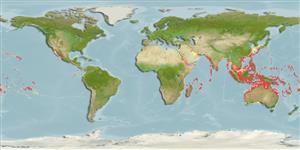Common names from other countries
Classification / Names / Names
ชื่อสามัญ | ชื่อพ้อง | Catalog of Fishes (gen., sp.) | ITIS | CoL | WoRMS
Environment: milieu / climate zone / depth range / distribution range
นิเวศวิทยา
; ระดับความลึก 0 - 66 m (Ref. 348). Tropical
Indo-Pacific: from East Africa, to eastern Polynesia; north to Japan and south to southwest Australia, Queensland, and New Caledonia.
Length at first maturity / ขนาด / น้ำหนัก / Age
Maturity: Lm ? range ? - ? cm Max length : 7.5 cm SHL เพศผู้/กระเทย; (Ref. 348); common length : 5.0 cm SHL เพศผู้/กระเทย; (Ref. 348)
Boring in soft rocks and dead coral or lithothamnion. Littoral and sublittoral to a depth of at least 66 m. Sometimes found burrowing in massive coral heads, but the burrow opening is always located in those portions which lack living polyps (Ref. 348).
Life cycle and mating behavior
วัยเจริญพันธุ์ | การสืบพันธุ์ | การวางไข่ | เซลสืบพันธ์ของเพศเมีย(ไข่) | ความดกของไข่ | ตัวอ่อน
Members of the class Bivalvia are mostly gonochoric, some are protandric hermaphrodites. Life cycle: Embryos develop into free-swimming trocophore larvae, succeeded by the bivalve veliger, resembling a miniature clam.
Poutiers, J.M. 1998. (Ref. 348)
IUCN Red List Status (Ref. 130435)
CITES status (Ref. 108899)
Not Evaluated
Not Evaluated
Threat to humans
Harmless
Human uses
การประมง: การค้า
| FishSource |
เครื่องมือ
ข้อมูลเพิ่มเติม
Age/SizeการเจริญเติบโตLength-weightLength-lengthสัณฐานวิทยาตัวอ่อนอุดมสมบรูณ์
แหล่งที่มาจากอินเตอร์เน็ต
Estimates based on models
Preferred temperature
(Ref.
115969): 24.2 - 29, mean 28 (based on 1552 cells).
Vulnerability
Low vulnerability (10 of 100).
